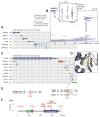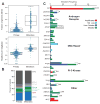The Molecular Taxonomy of Primary Prostate Cancer
- PMID: 26544944
- PMCID: PMC4695400
- DOI: 10.1016/j.cell.2015.10.025
The Molecular Taxonomy of Primary Prostate Cancer
Abstract
There is substantial heterogeneity among primary prostate cancers, evident in the spectrum of molecular abnormalities and its variable clinical course. As part of The Cancer Genome Atlas (TCGA), we present a comprehensive molecular analysis of 333 primary prostate carcinomas. Our results revealed a molecular taxonomy in which 74% of these tumors fell into one of seven subtypes defined by specific gene fusions (ERG, ETV1/4, and FLI1) or mutations (SPOP, FOXA1, and IDH1). Epigenetic profiles showed substantial heterogeneity, including an IDH1 mutant subset with a methylator phenotype. Androgen receptor (AR) activity varied widely and in a subtype-specific manner, with SPOP and FOXA1 mutant tumors having the highest levels of AR-induced transcripts. 25% of the prostate cancers had a presumed actionable lesion in the PI3K or MAPK signaling pathways, and DNA repair genes were inactivated in 19%. Our analysis reveals molecular heterogeneity among primary prostate cancers, as well as potentially actionable molecular defects.
Copyright © 2015 Elsevier Inc. All rights reserved.
Figures






Comment in
-
Re: The Molecular Taxonomy of Primary Prostate Cancer.Eur Urol. 2016 Jun;69(6):1157. doi: 10.1016/j.eururo.2016.02.024. Eur Urol. 2016. PMID: 27302140 No abstract available.
References
Publication types
MeSH terms
Substances
Grants and funding
- P30CA16672/CA/NCI NIH HHS/United States
- U24 CA143882/CA/NCI NIH HHS/United States
- 5U24CA143840/CA/NCI NIH HHS/United States
- 5U24CA143835/CA/NCI NIH HHS/United States
- U24 CA143843/CA/NCI NIH HHS/United States
- U24 CA143858/CA/NCI NIH HHS/United States
- R01 CA183793/CA/NCI NIH HHS/United States
- U24 CA143883/CA/NCI NIH HHS/United States
- 5U24CA143882/CA/NCI NIH HHS/United States
- P50 CA090381/CA/NCI NIH HHS/United States
- UL1 TR000005/TR/NCATS NIH HHS/United States
- P30 CA016672/CA/NCI NIH HHS/United States
- 5U24CA143843/CA/NCI NIH HHS/United States
- U54 HG003067/HG/NHGRI NIH HHS/United States
- U54HG003273/HG/NHGRI NIH HHS/United States
- P30 CA016056/CA/NCI NIH HHS/United States
- U24 CA143835/CA/NCI NIH HHS/United States
- R01 CA193837/CA/NCI NIH HHS/United States
- 5U24CA143867/CA/NCI NIH HHS/United States
- 5U24CA143866/CA/NCI NIH HHS/United States
- U24 CA143866/CA/NCI NIH HHS/United States
- U54HG003067/HG/NHGRI NIH HHS/United States
- U24 CA143845/CA/NCI NIH HHS/United States
- U24 CA143799/CA/NCI NIH HHS/United States
- 5U24CA144025/CA/NCI NIH HHS/United States
- U54 HG003273/HG/NHGRI NIH HHS/United States
- P30 CA008748/CA/NCI NIH HHS/United States
- U24 CA144025/CA/NCI NIH HHS/United States
- R01 CA131945/CA/NCI NIH HHS/United States
- 5U24CA143848/CA/NCI NIH HHS/United States
- U54HG003079/HG/NHGRI NIH HHS/United States
- U24 CA143840/CA/NCI NIH HHS/United States
- R01 CA175491/CA/NCI NIH HHS/United States
- 5U24CA143858/CA/NCI NIH HHS/United States
- U24 CA143848/CA/NCI NIH HHS/United States
- 5U24CA143845/CA/NCI NIH HHS/United States
- U54 HG003079/HG/NHGRI NIH HHS/United States
- 5U24CA143883/CA/NCI NIH HHS/United States
- U24 CA143867/CA/NCI NIH HHS/United States
- U24 CA199461/CA/NCI NIH HHS/United States
- R01 CA182503/CA/NCI NIH HHS/United States
- 5U24CA143799/CA/NCI NIH HHS/United States
LinkOut - more resources
Full Text Sources
Other Literature Sources
Medical
Molecular Biology Databases
Research Materials
Miscellaneous

